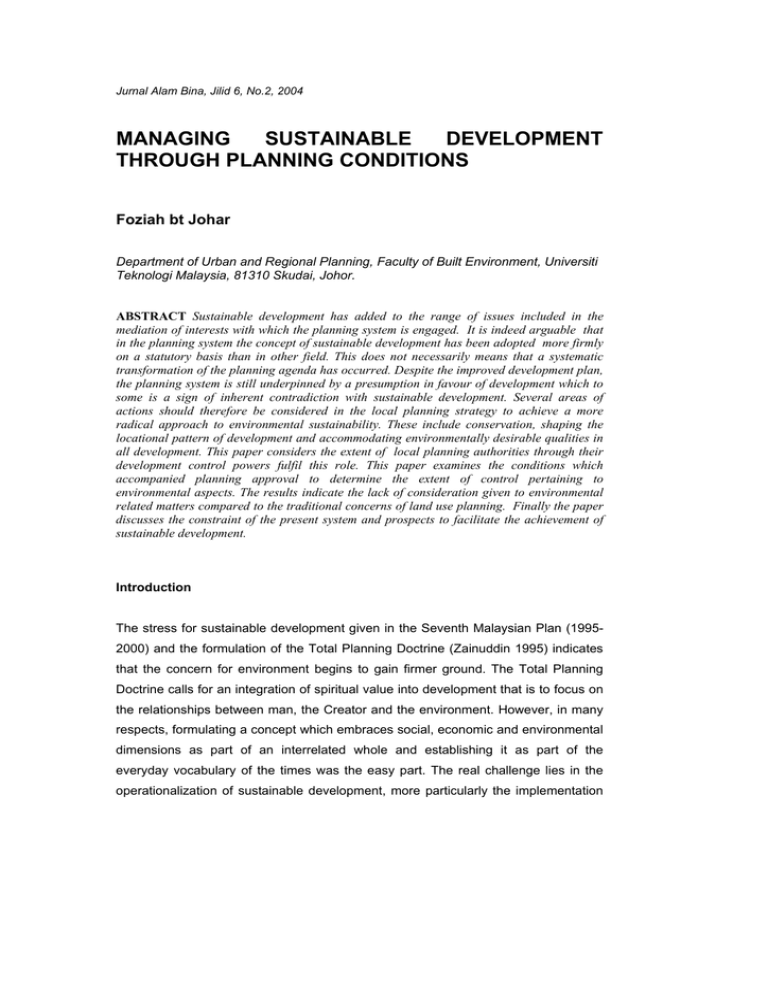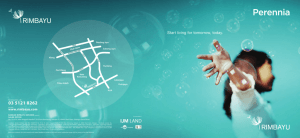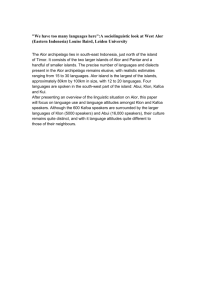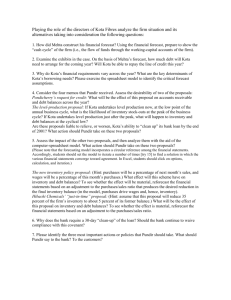MANAGING SUSTAINABLE DEVELOPMENT THROUGH PLANNING CONDITIONS Foziah bt Johar
advertisement

Jurnal Alam Bina, Jilid 6, No.2, 2004 MANAGING SUSTAINABLE DEVELOPMENT THROUGH PLANNING CONDITIONS Foziah bt Johar Department of Urban and Regional Planning, Faculty of Built Environment, Universiti Teknologi Malaysia, 81310 Skudai, Johor. ABSTRACT Sustainable development has added to the range of issues included in the mediation of interests with which the planning system is engaged. It is indeed arguable that in the planning system the concept of sustainable development has been adopted more firmly on a statutory basis than in other field. This does not necessarily means that a systematic transformation of the planning agenda has occurred. Despite the improved development plan, the planning system is still underpinned by a presumption in favour of development which to some is a sign of inherent contradiction with sustainable development. Several areas of actions should therefore be considered in the local planning strategy to achieve a more radical approach to environmental sustainability. These include conservation, shaping the locational pattern of development and accommodating environmentally desirable qualities in all development. This paper considers the extent of local planning authorities through their development control powers fulfil this role. This paper examines the conditions which accompanied planning approval to determine the extent of control pertaining to environmental aspects. The results indicate the lack of consideration given to environmental related matters compared to the traditional concerns of land use planning. Finally the paper discusses the constraint of the present system and prospects to facilitate the achievement of sustainable development. Introduction The stress for sustainable development given in the Seventh Malaysian Plan (19952000) and the formulation of the Total Planning Doctrine (Zainuddin 1995) indicates that the concern for environment begins to gain firmer ground. The Total Planning Doctrine calls for an integration of spiritual value into development that is to focus on the relationships between man, the Creator and the environment. However, in many respects, formulating a concept which embraces social, economic and environmental dimensions as part of an interrelated whole and establishing it as part of the everyday vocabulary of the times was the easy part. The real challenge lies in the operationalization of sustainable development, more particularly the implementation Foziah Johar of initiatives that do not merely pay lip-service to the words but actively do justice to the original concept. In order to assess land use planning’s contribution to sustainable development, a more systematic study of planning practice is employed. Studies of the operation of the development control system have emphasized the importance of development plan to planning decision. Although any discussion on sustainability development should cover all dimensions, namely social, economic and environmental, the focus of this paper is on the environmental aspect of planning. The framework provided by the plan particularly on environmental aspects was examined using 24 local plans. The plans were surveyed using the method of content analysis which is concerned with ensuring a systematic and objective inspection of varied documents (Bruff & Wood, 2000). In this study, the environmental content of a local plans is identified based on the guidelines of the Manual of Local Plan Preparation (JPBD 1993, 2001). The study concentrates on the policy direction and the guidelines which primarily form the basis for determining planning applications. Content analysis is also used to survey 100 planning permissions which were selected based on purposive sampling method to represent planning applications which essentially involved environmental related issues. Messages From Rio For Land Use Planning In many cases, particularly in developing countries, the scope of planning by local authorities is limited due to financial constraints and generally restricted mainly to a controlling one, i.e. the prevention of harmful development. The concern for sustainable development however requires that local authorities play a more meaningful role in urban development. The Rio Earth Summit proclaims twentyseven principles which would facilitate the transition to sustainability while Agenda 21 proposes a broad-based programme of action covering developmental and environmental issues in an integrated approach. Certain principles from the Rio Declaration and chapters of Agenda 21 can be translated into messages for urban planning, the most directly related as presented in Table 1. In short, it calls for an environmentally-led land use planning which should addressed environmental 2 Foziah Johar resource management. There must be an integration of environment and development in decision-making and there must be sustainable human settlements planning which integrate citizen participation in its planning and decision-making TABLE 1: Translating the Messages from Rio into the Land Use Planning Process Planning Stages Messages from Rio 1. Formulation of goals and objectives Should be ‘environment-led’. Strong, comprehensive planning laws which, as part of a wider body of environmental law, reflect modern understandings of natural processes. 2. Survey, analysis • Must address the meaning and consequences of sustainable development. There should be integrated planning and management resources. prediction and • 3. Generation and evaluation of alternative plans 4. Decision, implementing and monitoring • • • Environmental statement should be used as a principal means of minimising damage and uncertainty. Should include environmental resource management. Citizen participation in planning Information provision, community empowerment and subsidiary in planning. Institutions and non-governmental organizations play effective and efficient roles in environmental planning. Effective education, increased public awareness and training in citizen participation. Source: Adapted from Selman (1993). process, backed by strong, comprehensive planning laws which reflect modern understanding of natural resources. The messages cover a wide range of issues, from planning principles to planning process. When examined against the land use planning process, the messages could be used as criteria for evaluating whether a planning activity is striving to achieve sustainable development. 3 Foziah Johar Implementing Sustainable Land Use Planning Much has been said about the prerequisites for achieving sustainable development. Changes have to be made to values and ethics; knowledge has to be applied to better understand the relationship between man and nature; technology has to be improved to reduce any adverse effect of development; while others advocate institutional reformation. To date, there have been several moves to bring about these changes in the Malaysia planning practice. In 1995, amendments were made to the Town and Country Planning Act 1976 (the Act) which stressed the need for better environmental protection. The local plans which carry the details for development control must now provide measures for the preservation and enhancement of the natural features. In addition, developers must now prepare a planning evaluation report which should include study on natural features and provide measures to preserve them. The local authorities were also given powers to impose conditions accordingly. By the year 2000, the Federal Town and Country Planning Department has established 33 guidelines on various aspects of planning to help both developers and local authorities to better improve a proposed development. In 2001, further amendments were made to the Act which contributed to significant changes to the planning institutional framework. Among others, it provides for the establishment of the National Physical Planning Council chaired by the Prime Minister. Its main function is to promote the achievement of ‘sustainable development’ (the term introduced for the first time in the Act) by means of effective land use planning practice in the country. This will be translated in both the state structure plan as well as the local plan. Thus, land use planning will take place in a clear strategic framework stressing the top-down approach within it. Environmental Aspects in Local Plans Table 2 shows the main environmental issues faced by the local authorities as outlined by the local plans. Policy statements by the local plans to address those issues ranged from general policy such as “industries are encouraged to recycle” to 4 Foziah Johar detail statement such as “using interlocking bricks as impervious surface material”. It is however possible to generally categorise them into three groups based on their purpose i.e. forward planning or promotional policies, control and monitoring. It is apparent that the environmental chapter concentrates on issues relating to pollution and solid waste disposal. This was in line with the theme of environmental discourse in most structure plans prepared during the late 1980s and early 1990s which emphasised an active environmental care and management (Foziah 2001). The main concern for these plans is to reduce environmental degradation resulting from rapid economic development which has taken place during that period. These structure plans set out the policy framework for 85% of the local plans in this study. It should be noted that other environmental related issues are covered by other chapters of the local plans. The majority of local plans concentrate on measures to improve water TABLE 2: Environmental related issues in local authority areas Environmental issues % of local plan 83 1 Water/river pollution 2 Inadequate sewerage system 50 3 Encroachment of environmentally sensitive areas 37 4 Inadequate drainage system/flood 37 5 Inadequate and poorly maintained recreational facilities and open space 37 6 Conflicting land uses, obsolete buildings and abandoned land 37 7 Poor solid waste management 37 8 Traffic congestion 30 9 Air pollution 30 10 Inadequate and poorly managed urban landscape 30 11 Noise pollution 24 Source: Foziah (2003) quality as this form the major issue faced by most local authority area. About 70% of the plans recommended that both industrial and domestic waste be treated first before released to open stream or drains. Other recommendations include silt trap 5 Foziah Johar during construction. Not all policy statements are applicable for development control purpose as they are still general to enable them to be really useful. This study further identified guidelines that can be applied at the development control stage and they are shown in Table 3. It can be seen that the scope of guidelines vary from one local plan to another. TABLE 3: Guidelines on environmental aspects provided by selected local plans which are applicable at development control stage Aspects Air quality Guidelines - Every factory to install dust control mechanism - Tree planting (high density in buffer zone and road side) - To pave road, silt trap during construction and ground cover - Provide buffer zone between conflicting land use Water quality Noise control - Every manufacturing factory to have treatment system - Carry out EIA for potentially polluted projects and projects more than 50 hectares - Constructions to be carried out during appropriate season - Install silt trap during construction - Provide treatment system for surface water runoff - Provide retention pond - Development in accordance with guidelines of Dept. of Drainage and Dept. of Town & Country Planning - Provide buffer zone - Tree planting with dense texture Solid waste Environmentally sensitive area - Every settlement to provide waste disposal site - Prohibit tree felling - Preserve building/area having significant interest - Development in hilly areas and river reserve to follow guidelines of Dept. of Drainage and Dept. of Town & Country Planning) - Housing density in accordance with slope capacities - Development not allowed on slope of more than 25 degree - Hydraulic study for development near water bodies Source: Foziah (2003). 6 Local plans Taiping, Bukit Mertajam, Kota Setar Kota Setar, Seremban, Alor Gajah, Padang Lalang, Tampoi-Larkin-Kempas, Bangi-Semenyih-Beranang Kota Bharu, Bandar Maharani, Kota Setar, Bukit Mertajam, Alor Gajah Kulim-Junjung, Padang Lalang, Kota Bharu, Tampoi-Larkin-Kempas, Melaka, Bangi, Alor Gajah, Kota Tinggi Bukit Mertajam, Bandar Maharani Kota Setar, Bukit Mertajam, Kota Bharu, Tampoi-Larkin-Kempas, BangiSemenyih-Beranang Seremban, Bangi-Semenyih-Beranang, Batu Burok-Chendering Bandar Maharani, Padang Lalang Melaka, Padang Lalang Seremban, Alor Gajah Alor Gajah, Bangi-Semenyih-Beranang, Batu Burok-Chendering Kota Setar, Bukit Mertajam, Kota Bharu, Alor Gajah, Skudai Kota Bharu, Alor Gajah, Parit BuntarBagan Serai, Padang Lalang Kota Bharu Taiping Kangar Seremban, Batu Burok-Chendering Kulim-Junjung, Batu Burok-Chendering Kulim-Junjung, Alor Gajah, TampoiLarkin-Kempas, Batu Burok-Chendering Padang Lalang, Bangi-SemenyihBeranang Foziah Johar The local plans prepared in accordance with the 1995 amendment are more focused, having less written statement and more graphics to illustrate the proposals. The written statements are also accompanied by the development guidelines, often in separate volume. It has been suggested that certain areas of action should be adopted to enable the achievement of sustainable development at local level (Healey and Shaw 1993). Several of these areas have long been established in the planning system in this country and clearly outlined in the local plans. These areas include conservation, shaping the locational pattern of development, promoting particular types of development and enhancing certain qualities in development. Other areas such as pollution control targets and compensation for environmental damage are less familiar areas, as such, are seldom addressed by the local plans. Planning Conditions and Environmental Quality Development at the local level obviously involves a considerable number of policies and implementation of decisions which have to consider the cost and benefit to every level of urban dwellers. The interdependency between investments and their environment and the need to integrate all groups of inhabitants in urban society under decent living condition would be the prime concern of urban planners and managers at local level (Foziah et al. 2003). In many cases, it will be possible to determine the environmental consequences of a proposal with a reasonable degree of confidence. Under Malaysian law, the mechanism to evaluate the potential impact of development on the environment is the environmental impact assessment (EIA) which is governed by the Environmental Quality Act (1985 Amendment) and administered by the Department of Environment. The development control system is however carried out by the local planning authority and may not involve the EIA. Local planning authorities have a wide power to impose conditions on a grant of planning permission (the Act, s 22(3)). It is well established that conditions must serve planning purposes, must be fairly and reasonably related to the subject matter of the application and must not be unreasonable in the administrative law sense (Rowan-Robinson et al. 1995). Theoretically, conditions can be employed to achieve environmental safeguards and could thereby contribute to ensuring that development does not have negative impact on the environment. The 1995 amendment has widen 7 Foziah Johar this control to enable local authorities to impose conditions pertaining to the above requirements. As mentioned earlier, the amendment to the 1976 Act required that certain environmental aspect of the development should be enhanced and powers given to the local authority to control them accordingly through the imposition of conditions. This study indicates that planning conditions can generally be categorised into four main groups according to their purpose. These include i) conditions to improve the physical environment; ii) conditions relating to the design and layout of the development; iii) conditions relating to provision of infrastructure and amenities; iv) conditions to improve the quality of the environment (Table 4). Among the conditions used to improve the physical environment, the most frequently used is the requirement to provide open space and tree planting. More than 70% of the permissions carried these conditions in the “very clear” category compared to other conditions in the same category which are imposed to about 20% of the permission. A large proportion of conditions other than provision of open space are not site specific. It is interesting to note that more than fifty percent of the permissions do not mention the tree felling prohibition whereas only 5% of them do not carry the condition relating to open space. One third of the samples do not carry any condition relating to preservation of the natural topography or restricting any form of disturbance to the natural resources. Conditions related to measures to improve the quality of environment include: a) measures to prevent and control water/air/noise pollution; ii) waste disposal management; iii) siting and zoning of industries; iv) traffic management; and v) provision of footpath. All these aspects are generally considered in determining the planning application. However, the detail of these conditions particularly as regards to clarity and coverage is still questionable. The average permissions which carry these conditions in a clear manner is 22.5%, i.e. less one per cent from those that do not have these condition at all while another 22% of the samples have these conditions worded in a general manner. 8 Foziah Johar Two possible interpretations emerge from these findings. They could suggest that local authority regard these issues as important and view conditions as powerful means for controlling the physical environment. The highly generalised conditions might suggest, then, a level of understanding of the intention in imposing conditions on the part developers, which would ensure implementation. Alternatively, it would be possible to imply that the use of generalised conditions and concern for detail as a reflection of the belief that environmental aspects was only peripherally important in the development control process. This would be consistent with the findings on the provision of local plans which lack clear guidelines. This differs from provisions on design and layout of buildings and guidelines on social facilities which are more site and performance specific. It is also consistent with the performance of conditions related to these matter which generally have a higher frequency than environmental related conditions. TABLE 4: Planning conditions according to categories of clarity Conditions Categories (%) Site and performance specific Site or performance specific General Not mentioned Conditions to improve the physical environment Prohibit damage to the land, its physical environment, natural topography and landscape Prohibit the removal or alteration of any natural features of bthe land 18.0 29.0 21.0 32.0 19.0 24.0 24.0 33.0 Prohibit the felling of trees of certain characteristics Planting or replanting of trees with certain characterisctics. Making up of open space 11.0 24.0 12.0 53.0 23.0 52.0 17.0 8.0 39.0 42.0 14.0 5.0 Condition to improve the quality of environment Prevent water/air/nose pollution during construction Control pollution after construction is completed Adherence to guidelines on sitting and zoning of industries Provide comprehensive footpath system Conditions related to traffic management 19.0 23.0 39.0 19.0 16.0 20.0 26.0 38.0 27.0 38.0 18.0 17.0 12.0 16.0 24.0 22.0 28.0 32.0 36.0 30.0 23 12.0 24 12.0 Conditions related to layout and amenities Conditions related to design and layout Provision of infrastructure and social amenities Source: Foziah (2003) 9 32 42.0 21 33.0 Foziah Johar It is assumed that the cause of problems in making environmental valuation are the knowledge and attitudes of individuals towards the natural development. These problems can be solved by getting people to adopt a more ethical orientation towards the environment (Healey & Shaw, 1993). This study has also carried out an opinion survey to gauge the perception of the personnel in charge of development control on sustainable development (Table 5). Most of the definitions clearly emphasised the significance of environmental aspects, which ran parallel to the need of environmental-led planning. The respondents do not however rank environmental benefits as their top priority in deciding a planning application. TABLE 5 : Keywords used to define sustainable development No. Keywords Development which emphasised environment Development which is in balance with environment Continuous development Balanced development which integrate all aspects Development which take into account the future requirement Source: Foziah (2003) Environmental benefits was ranked as the last priority after the social and economic gains. This is consistent with the frequency of environmentally related conditions levied to the planning approval. It has been shown that conditions related to preservation of topography, provision of open space and improvement of landscape are more frequently used than those concerning the preservation of sensitive area, evaluation of environmental impact, alternative control of negative impact and earth work (Foziah, 2003). Although this is not an absolute indication of how priorities are ranked, the findings are nevertheless indicative of the ‘technocentrism’ inclination among the respondents. 10 Foziah Johar Conclusion There is no doubt that land use planning control contributes to better environmental management. It plays significant role in improving the overall amenity especially in the urban areas. This is in line with the traditional concerns of land use planning which is to ensure maximum convenience and beauty while facilitating economic and social well-being (Keeble, 1969). However, the achievement of sustainable development requires that planning be environmental-led. In general terms, planning powers are wide enough and the tools of control are sufficiently versatile to secure that land use and development objectives are compatible with sustainable development, if local planning authorities can be persuaded to use them. The study however indicates that planning control vis-à-vis planning conditions are still focusing on the physical design aspects and amenities which represents the concern for safety and convenience. There is therefore the needs to take the next step of indicating exactly how planning should operationalize the concept of sustainable development in development plans and development control, and allow planning to take a more holistic approach but without extending the remit of planning so wide that it becomes meaningless. There are however several areas of process where difficulties could arise. First, the general approach to the operation of development control does not square with the precautionary approach which is very much a part of the approach to sustainable development. The attitude and practice of development control is that applications should be allowed unless they would cause to interests of acknowledged importance. Although they may be circumstances in which development plan can support a precautionary approach, these circumstances will be limited. If sustainable development is to be an important factor in development control, it is necessary to review the extent of the presumption in favour of development. The second difficulty arises from the “once and for all” nature of development control. There is no effective way in which a local planning authority can review the adequacy of control in the light of changing circumstances and advance technology. Consideration needs to be given to providing authorities with effective tools for extending the scope and process to encompass monitoring and review. 11 Foziah Johar Land use planning is not the only policy process seeking to achieve sustainable development. Local Agenda 21 (LA21) has been identified as the key to the process of moving towards sustainable development. LA21 has a much wider remit than the statutory planning system. The key issue here, however, is whether statutory planning and LA21 are combining to develop effective environmental policy and practice. The fundamental difference being the land use planning system is essentially a top-down process with its statutory background, whereas LA21 is very much a bottom-up community-based process. References Bruff, G.E. & Wood, A.P. (2000). Local sustainable development: land use planning’s contribution to modern local government. Journal of Environmental Planning and Management 43(4) : 519-539. Foziah Johar (2001). Environmental considerations in statutory planning: evolving policies in development plans, Malaysian Journal of Environmental Management 2: 3-24. Foziah Johar (2003). Amalan kawalan perancangan Pihak Berkuasa Perancangan Tempatan di Malaysia : Tumpuan kepada aspek alam sekitar. PhD Thesis Universiti Kebangsaan Malaysia, Bangi. Foziah Johar, Ahris Yaakup, Susilawati Sulaiman, Ruslin Hassan & A.Rashid Ibrahim (2003). GIS and development control system for a local authority in Malaysia. Habitat International 27 : 683-696. Healey, P. & Shaw, T. (1993). “The treatment of environment by planners: evolving concepts and policies in development plans”. Working paper no 31. Centre for research in European urban environment, University of Newcastle upon Tyne. Jabatan Perancangan Bandar & Desa (JPBD)(1993). Manual penyediaan rancangan tempatan. Kuala Lumpur: Jabatan Perancangan Bandar & Desa Persekutuan. Jabatan Perancangan Bandar & Desa (JPBD) (2001). Manual penyediaan rancangan tempatan (Pindaan). Kuala Lumpur: Jabatan Perancangan Bandar & Desa Persekutuan. Keeble, L. (1969). Principles and practice of town and country planning. London: Estates Gazette. Rowan-Robinson, J., Ross, A. & Walton, W. (1995). Sustainable development and the development control process. Town Planning Review 66(3): 269-286. Selman, P. (1993). Landscape ecology and countryside planning: visions, theory and practice. Journal of Rural Studies 9: 1-21. Zainuddin Muhammad (1995). “Planning system and procedures in planning approval”. Seminar on Land use development and transactions in Malaysia, Kuala Lumpur. 12



